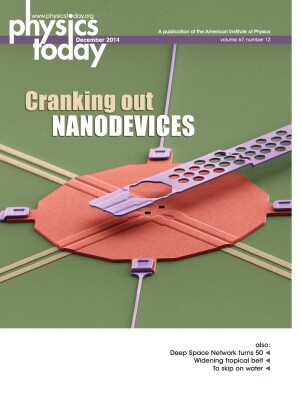Fusion breeding for sustainable carbon-free power
DOI: 10.1063/PT.3.2605
Any reasonable option for midcentury, sustainable, carbon-free power should be given serious attention. In an earlier letter to Physics Today (May 2012, page 12
Consider the following: The cost of ITER has grown considerably and its completion date has been dramatically extended. Tokamaks will probably never be economical stand-alone pure fusion reactors, but they could be fusion breeders. The National Ignition Facility has missed its gain milestone by about three orders of magnitude. And recently the US Congress has taken a hard and unsympathetic look at fusion.
Meanwhile, green energy is not living up to its promise. According to a speech by German vice chancellor Sigmar Gabriel to his nation’s solar industry leaders in April 2014, the collapse of that country’s green-energy infrastructure seems imminent, and Germany’s use of soft coal has significantly increased, which in turn has raised greenhouse gas emissions and electricity prices. In fact, any computer search will show that coal use has greatly increased worldwide in the past decade.
Although there are no guarantees that pure fusion and green energy will continue to fail or that coal use will continue its rapid increase, most indications are discouraging. Hence it seems appropriate to pay more attention to another option for sustainable, carbon-free midcentury power: fusion breeding.
A fusion breeder can fuel many thermal nuclear reactors of equal power. It takes two fast-neutron fission reactors at maximum breeding rate to fuel a single thermal nuclear reactor. (A single fast neutron reactor, however, can be configured to burn the actinide waste products—principally plutonium—of many thermal nuclear reactors of equal power.)
Developing fusion breeding will take decades of dedicated effort, but it is much more achievable than pure fusion. In any case, fuel for fission reactors is currently available and will be for a few decades. The time to develop fusion breeding and the time to largely deplete conventional nuclear fuel could well match up. A review article 1 and a textbook chapter 2 offer more details regarding the plasma physics and nuclear aspects of fusion breeding. It might well be that fusion breeding could develop into a sustainable, carbon-free power source by midcentury.
References
1. W. Manheimer, J. Fusion Energy 33, 199 (2014). https://doi.org/10.1007/s10894-014-9690-9
2. R. Moir, W. Manheimer, in Magnetic Fusion Technology, T. Dolan, ed., Springer (2013), chap. 14.
More about the Authors
Wallace Manheimer. (wallymanheimer@yahoo.com) Allendale, New Jersey .
